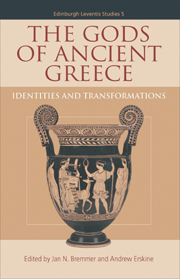Book contents
- Frontmatter
- Contents
- Preface
- List of Illustrations
- Notes on Contributors
- List of Abbreviations
- Introduction: The Greek Gods in the Twentieth Century
- 1 What is a Greek God?
- PART I SYSTEMATIC ASPECTS
- PART II INDIVIDUAL DIVINITIES AND HEROES
- 8 Zeus at Olympia
- 9 Zeus in Aeschylus: the Factor of Monetization
- 10 Hephaistos Sweats or How to Construct an Ambivalent God
- 11 Transforming Artemis: from the Goddess of the Outdoors to City Goddess
- 12 Herakles between Gods and Heroes
- 13 Identities of Gods and Heroes: Athenian Garden Sanctuaries and Gendered Rites of Passage
- PART III DIACHRONIC ASPECTS
- PART IV HISTORIOGRAPHY
- Epilogue
- Index
13 - Identities of Gods and Heroes: Athenian Garden Sanctuaries and Gendered Rites of Passage
from PART II - INDIVIDUAL DIVINITIES AND HEROES
Published online by Cambridge University Press: 05 August 2013
- Frontmatter
- Contents
- Preface
- List of Illustrations
- Notes on Contributors
- List of Abbreviations
- Introduction: The Greek Gods in the Twentieth Century
- 1 What is a Greek God?
- PART I SYSTEMATIC ASPECTS
- PART II INDIVIDUAL DIVINITIES AND HEROES
- 8 Zeus at Olympia
- 9 Zeus in Aeschylus: the Factor of Monetization
- 10 Hephaistos Sweats or How to Construct an Ambivalent God
- 11 Transforming Artemis: from the Goddess of the Outdoors to City Goddess
- 12 Herakles between Gods and Heroes
- 13 Identities of Gods and Heroes: Athenian Garden Sanctuaries and Gendered Rites of Passage
- PART III DIACHRONIC ASPECTS
- PART IV HISTORIOGRAPHY
- Epilogue
- Index
Summary
‘What is a Greek god?’ was the question addressed by Albert Henrichs in chapter 1 of this volume. The question I would like to ask here concerns a group of female divinities belonging to the classical Athenian pantheon all associated with sites characterized as garden sanctuaries. From the perspective of landscape architecture it is this: ‘What would the Greek gods amount to if they were not associated with heroes?’
HEROIC AETIOLOGIES
A significant number of the Attic tragedies that have come down to us end with an aetiological section involving the establishment of a cult. This is particularly true of the tragedies of Euripides. One of the best-known examples comes from Euripides' Hippolytos. Among the consequences of Hippolytos' tragic death is that his tomb at Troezen is to become the focus of a hero cult in which ritual acts will be performed. On the eve of their marriage, the girls of the city will cut off their hair and offer it to the young hero who denied the power of Aphrodite and refused to accept his own adulthood. This prenuptial ritual is attested also in other Greek cities: the memory of the young hero who has died in tragic circumstances is kept alive in performances consisting of musical offerings and the cult associates the hero with the goddess who encompassed his downfall – Aphrodite.
- Type
- Chapter
- Information
- The Gods of Ancient GreeceIdentities and Transformations, pp. 245 - 270Publisher: Edinburgh University PressPrint publication year: 2010



